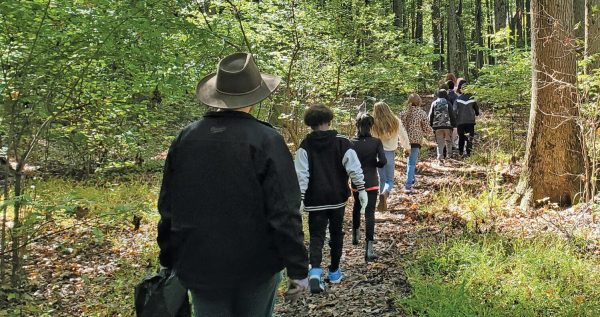
Project: Invasive species threaten our native plants by crowding them out and outcompeting them for resources. They also have the added benefit of being unencumbered by disease, parasites, or herbivores. Join us as we work to remove them from around our native plants to give them the space they need to thrive. Work level: Easy […]
Read More…

Project: Garlic mustard was first found in Long Island, NY, in 1868, and was brought here from Europe as a food and medicinal source. The roots from this plant secrete chemicals that inhibit the growth of soil fungi, which are essential for connecting seedlings to the forest network of roots from older trees. Additionally, garlic […]
Read More…

Project: Join us as we plant native trees and shrubs in the area we’ve been working on all winter and spring. A healthy riparian buffer stabilizes eroding streambanks, absorbs excess water runoff, fertilizers and pesticides, filters sediment, and cools the water making it more hospitable to a diversity of organisms. Work level: Moderate Tools: We […]
Read More…

Project: Garlic mustard was first found in Long Island, NY, in 1868, and was brought here from Europe as a food and medicinal source. The roots from this plant secrete chemicals that inhibit the growth of soil fungi, which are essential for connecting seedlings to the forest network of roots from older trees. Additionally, garlic […]
Read More…

Project: Garlic mustard was first found in Long Island, NY, in 1868, and was brought here from Europe as a food and medicinal source. The roots from this plant secrete chemicals that inhibit the growth of soil fungi, which are essential for connecting seedlings to the forest network of roots from older trees. Additionally, garlic […]
Read More…

Project: Garlic mustard was first found in Long Island, NY, in 1868, and was brought here from Europe as a food and medicinal source. The roots from this plant secrete chemicals that inhibit the growth of soil fungi, which are essential for connecting seedlings to the forest network of roots from older trees. Additionally, garlic […]
Read More…

Project: Garlic mustard was first found in Long Island, NY, in 1868, and was brought here from Europe as a food and medicinal source. The roots from this plant secrete chemicals that inhibit the growth of soil fungi, which are essential for connecting seedlings to the forest network of roots from older trees. Additionally, garlic […]
Read More…

Project: Garlic mustard was first found on Long Island, NY, in 1868, and was brought here from Europe as a food and medicinal source. The roots from this plant secrete chemicals that inhibit the growth of soil fungi which are essential for connecting seedlings to the forest network of roots from older trees. Additionally, garlic […]
Read More…

Project: Join us for invasive plant management! We’ve applied for another riparian forest buffer grant and must clear invasive shrubs from along the stream in preparation for another planting. Winged euonymus (a.k.a. burning bush or flame bush) has grown in profusion along the stream, and many years of dedicated management continues as we cut and […]
Read More…

Project: Join us for this week’s Fridays in the Forest workday at Quakertown Swamp for invasive praying mantis control. No, they are not protected by law! For a variety of reasons, invasive praying mantises have become quite numerous and are taking a toll on our native insects – including the struggling monarch butterfly. Help us […]
Read More…





